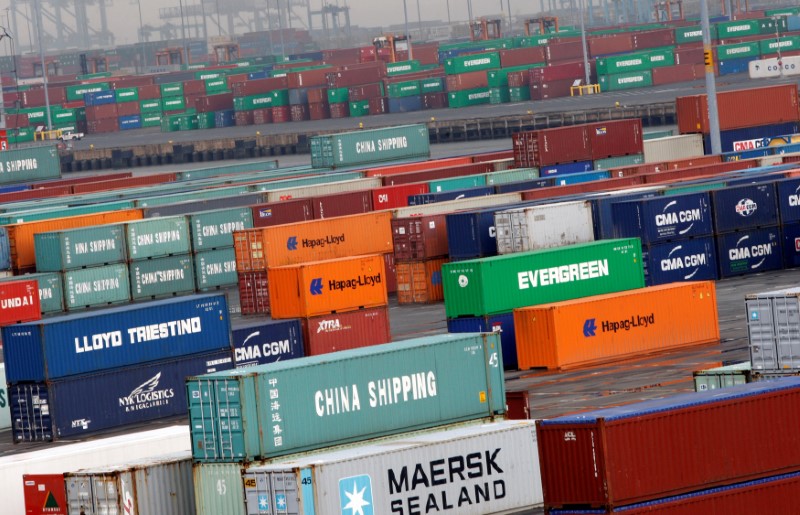By Lucia Mutikani and David Lawder
WASHINGTON (Reuters) - The U.S. trade deficit widened more than expected in December to its highest level since 2008, as robust domestic demand pushed imports to a record high, adding to the stiff headwinds faced by the Trump administration's "America First" trade policies.
The import-driven surge in the trade gap reported by the Commerce Department on Tuesday also suggests 3 percent annual economic growth may be hard to achieve. Imports, which subtract from gross domestic product, could get a further boost from a $1.5 trillion tax cut package that became effective in January.
The fiscal stimulus comes with the economy almost at full employment, which means the resulting increase in demand will likely be satisfied with imports. Companies would also need to invest in equipment, some of which is bought overseas, to boost production.
"Trump's trade team has not been able to stem the flood of imports into the country," said Chris Rupkey, chief economist at MUFG in New York. "Don't forget it is American companies assembling goods outside the country and then bringing them back in which is the problem with the trade imbalance in goods."
The trade deficit increased 5.3 percent to $53.1 billion in December, the highest level since October 2008. Economists polled by Reuters had forecast the trade gap widening to $52.0 billion in December. Part of the rise in the trade gap reflected higher commodity price increases.
The deficit surged 12.1 percent to $566.0 billion in 2017, the highest since 2008. That represented 2.9 percent of GDP, up from 2.7 percent in 2016.
The politically sensitive U.S.-China trade deficit jumped 8.1 percent to a record $375.2 billion last year. President Donald Trump has vowed to shrink the trade gap by shutting out more unfairly traded imports and renegotiating free trade agreements.
Trump has repeatedly threatened to terminate the North American Free Trade Agreement unless the 1994 pact linking Canada, Mexico and the United States can be made more favorable to Washington. And his administration has launched an investigation into China's intellectual property practices that could lead to major new trade sanctions on Beijing.
"Many American factory workers bought into the promise of the president's trade policy reforms, but they are still waiting for results," said Scott Paul, president of the Alliance for American Manufacturing.
When adjusted for inflation, the trade deficit increased to $68.4 billion from $66.5 billion in November.
The jump in the so-called real trade deficit at the end of the year puts trade on course to be a drag on GDP in the first quarter. Trade subtracted 1.13 percentage point from economic growth in the final three months of 2017.
The economy grew at a 2.6 percent annualized rate during that period, helping to lift growth in 2017 to 2.3 percent from 1.5 percent in 2016.
U.S. stocks rose in volatile trading following the biggest one-day declines for the S&P 500 index (SPX) and Dow Jones Industrial Average (DJI) in more than six years. The dollar (DXY) rose against a basket of currencies as investors sought a safe-haven from the stock market rout. Prices of U.S. Treasuries were trading higher.
BROAD TARIFFS
The Trump administration believes a smaller trade deficit, together with deep tax cuts, could boost annual economic growth to 3 percent on a sustained basis. Late in January, Trump imposed broad tariffs on imported solar panels and large washing machines, and is considering slapping tariffs or quotas on steel and aluminum for national security reasons.
Such actions may prove politically popular with Trump's working-class supporters, particularly in states hard-hit by factory closures and import competition. But economists say they would likely do little to change the growth trajectory of the overall trade deficit, which is tied more to macroeconomic factors.
Goods imports increased 2.9 percent to a record $210.8 billion in December. Imports of food, capital and consumer goods were the highest on record in December. Imports of consumer goods were buoyed by pharmaceutical preparations, cellphones and motor vehicles.
Imports are being driven by robust domestic demand, which grew at its quickest pace in more than three years in the fourth quarter. The country's import bill in December was also pushed up by more expensive crude oil, which averaged $52.10 per barrel, the highest price since July 2015.
"Tax reform is probably going to put further pressure on the trade and current account deficit as firms invest in more capital equipment to increase productive capacity," said Eugenio Aleman, a senior economist at Wells Fargo (NYSE:WFC) Economics in Charlotte, North Carolina.
Imports from China fell 7.6 percent in December. There were also declines in goods imported from Canada and Mexico, the United States' major trading partners.
Exports of goods increased 2.5 percent to $137.5 billion in December, the highest level since October 2014. Exports of capital goods hit a record high, lifted by civilian aircraft and industrial machines.
There were also gains in exports of industrial supplies and materials. Petroleum exports increased to their highest level since August 2014.
Exports are being boosted by a strengthening global economy. A weakening dollar is also making American-made goods more competitive on the international market.

Exports to China surged 7.5 percent to a record high in December. As a result, the U.S.-China trade deficit declined 13 percent in December.